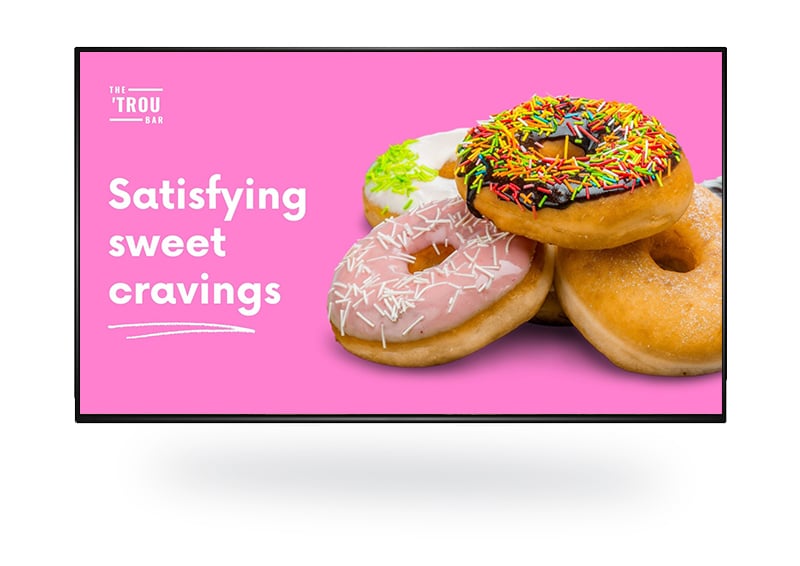Most of the people we speak to about digital signage are first-time adopters, researching the technology for the first time. Rather than replacing an outdated or under-performing digital solution, they are actually replacing traditional, static media such as posters and noticeboards. When considered in this light, the question becomes digital signage vs print – which is the right fit for your environment?
Technological solutions are quickly being adopted across all industries. However, many businesses still rely on posters and static print media to convey important information. In a fast-paced world where information is being constantly changed and updated, it is crucial your audience is getting the most relevant and up-to-date messages.
In this blog, we will analyse the benefits of digital signage vs print and investigate which medium is best for your organisation.
Cost Effectiveness
For all organisations, keeping expenses to a minimum is of high importance. Organistations want to ensure their money is being well spent and being put to good use. For a smaller organisation, efficient solutions can help save time and money. This leaves more resources for marketing and sales to help them rise above their competition. For larger organisations, even a small percentage reduction across a large communication network can have a significant effect on the bottom line.
On the surface, traditional posters can appear to be more of a cost-effective solution. In the short term, this can be true. Of course in a single-use case scenario, purchasing a single poster vs a digital screen will be cheaper. However, if you’re planning on updating the content and design of the poster on a regular basis, this couldn’t be further from the truth.
Take an estate agency, for example. The price of regularly creating, printing, and replacing traditional paper posters or LED light pockets in a window display can be surprisingly high. Any environment where information needs to be updated regularly creates a high turnover of paper media and with that a cost – not only in materials but more notably – time. The problem is compounded if your business has to outsource this graphic design and print work to a third party or marketing agency. In addition to this, your organisation will need to pay for and source someone to install and update the paper media, each-time there is a content change. If your poster network spans multiple sites, this cost will quickly add up!
Cloud-based digital signage has done well to solve this issue. Through cloud-based software and robust hardware, your network will only need to be installed once. When connected to the internet, your organisation can control all the screens from a single location. This means you don’t need a physical employee to go around updated each individual screen – saving you time and money. Additionally, your content team can schedule content to play on the screens up to years in advance. This set and forget feature, can save a great deal of time and therefore time when it comes to content deployment. With traditional methods, content would need to be updated and changed in real-time.

Grabbing Attention: Digital Signage Vs Print
Posters have been around for a long time. In many cases, this can indicate the technology is strong. For posters, however, it seems to have had the opposite effect. Humans have gotten so used to posters being around, that they just blend into the background. The content becomes quickly outdated and loses engagement.
In a world where almost everyone has a smartphone and personal computer, we are conditioned to consume information and media in this way. When we check our digital devices, we expect updated information. If you think about it, have you ever checked the news to want old stories? No, you want the newest and latest information. Digital signage allows for dynamic, constantly changing content. Instead of just being the same old design, the screen can play through dosens of different creatives to suit various audiences and use cases. In addition to this, the screen can pull in content from live sources such as news, data, and social media. This helps keep content fresh and users updated.
Screens can also help attract attention through bright display, engaging animations, and interactive elements. They cater to a shorter attention span and ensure that people will notice the message. A survey done by FedEx reports that 8 in 10 customers entered a store, because of digital signage. This reflects the power of digital signage when it comes to grabbing attention. People are drawn in by the eye-catching visuals and take action, where they otherwise wouldn’t.

Wear And Tear
When you install a communications system you want it to last. The last thing you want to be doing is constantly booking in repairs, maintenance, and replacements. You want to install your solution and have peace of mind knowing that your content continues to look great.
When freshly installed, there’s no doubt print media looks great! However, due to weather, vandals, and general wear and tear your content’s appearance can quickly drop. This is especially true with outdoor print media. For example, outdoor posters can easily be damaged by bad weather or graffiti. A single rainy day can destroy the paper, meaning, the poster will need to be replaced. You may argue “surely indoor posters are okay?”. Although they’re safe from the weather, they are still at risk from vandals. In addition, colours can quickly fade in direct sunlightlight, ruining your great content.
Digital signage, however, is built to last. Commercial-grade displays are built for purpose and designed to stand the test of time, weather and vandals. Depending on your project, screens can include additional features such as hard-casing, to further protect your hardware and content. They often require less maintenance too. If your digital displays get dirty, you can simply wipe them clean – they’ll look good as new in no time!

Engaging Customers
Ensuring your messages are engaging should be at the top of your list in regards to communications. If your audience isn’t engaged, it is essentially like whispering in the middle of the ocean – nobody is going the hear what you have to say. So how can you make your communications more engaging?
Statistics report that video content is one of the most engaging content types. With video, your organisation can create eye-catching dynamic messages that are sure to capture the attention of your audience. Instead of them having to go to great lengths to read a paragraph of text, the message can be quickly summarised in a short video. Furthermore, videos have proved to bring positive results by generating more traffic and sales in comparison to other media types. Unfortunately, posters lack the ability to feature videos and dynamic content. Therefore, organisations still using print methods, have been unable to take advantage of this fantastic medium.
One of the reasons digital displays are so good for engagement is the variety of content users can show in a single location. Through a range of widgets and integrations, users can provide large levels of value and relevancy to their audience. For example, on a single screen, a user could show social media updates, company messaging, live data charts, video, and news feeds – all on just one screen. With print media, the user would have to pick and choose the content they display.
Furthermore, the physical screens themselves can prove to be a huge draw for engagement. When you think of a digital poster, you may think of a standard TV. However, other deployments come in more futuristic formats – interactive touch screens and kiosks, or impressive multi-screen video walls, can prove to capture attention in almost any environment.
Updating Content: Digital Signage Vs Print
Above, we briefly mentioned the importance of keeping content fresh and up to date. In the modern world (and especially with the introduction of the pandemic) having access to the latest and most relevant information is imperative. In just a day, information can become heavily irrelevant. Therefore, ensuring your communications remain relevant should be a priority to any organisation.
The challenges of keeping this information up-to-date are amplified by large communication networks or organisations. For these situations, powerful, easy-to-work solutions are required.
Take the pandemic as an example. Especially towards to beginning, information was changing by the hour. Poor communication lead to mass confusion on what advice and guidelines to follow. Organisations would print out a poster relating to safety advice, and in most cases, that advice would be out of date. The organisation would then need to print out new posters to meet new advice. Those with digital signage were able to download the latest safety content from the government and have it live on their screen network in seconds. This ensured audiences were digesting the most relevant advice.
If you have any questions related to digital signage vs print media, speak to an expert today. Call our friendly team on 02380 981110 or Email info@troudigital.com for a no-obligation consultation. Alternatively, click the button below.
